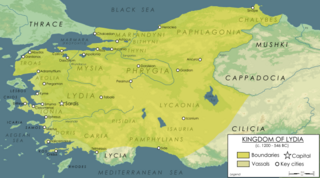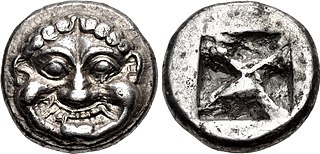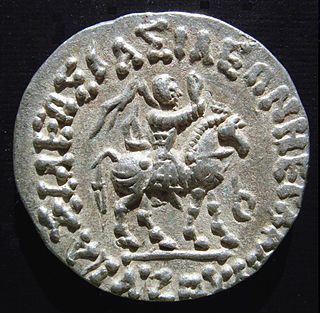
The Phanes coins, so called for the name inscribed on them, are early electrum coins from Caria in Asia Minor and are the most ancient inscribed coin series at present known.

The Phanes coins, so called for the name inscribed on them, are early electrum coins from Caria in Asia Minor and are the most ancient inscribed coin series at present known.
The Phanes coins are a series of coins issued in seven denominations: stater, 1/3, 1/6, 1/12, 1/24, 1/48, and 1/96 stater. The staters weigh 14.1 grams. All of the coins have the image of a stag or part of a stag on them. [1] The coins were likely struck at Ephesus. [2]
The stater and 1/3 stater coins from this series both bear Greek inscriptions. [1] The inscriptions are written right-to-left, and the letters are the mirror image of standard Greek letters. [3] The longer inscription, on the stater, survives in three versions, which read: ΦΑΕΝΟΣ ΕΜΙ ΣHΜΑ ("Phaenos emi sema"), ΦΑΝΟΣ ΕΜΙ ΣHΜΑ ("Phanos emi sema"), and ΦΑΝΕΟΣ ΕΙΜΙ ("Phaneos eimi"). [1] This may be translated as "I am the badge/mark/symbol of Phanes" or "I am the sign of the bright one". [4] [a] The shorter legend, on the 1/3 stater coins, is ΦΑΝΕΟΣ ("Phaneos", meaning "of Phanes"). [1]
The coins of Phanes are amongst the earliest of Greek coins. One, a hemihekte (a twelfth stater) of the issue, was found in a jar in the foundations of the Temple of Artemis at Ephesus dated to the late seventh century BC, making that the earliest known hoard of coins. [6] Only six specimens of the stater are known. [7]

Phanes cannot be identified with certainty. He might have been the successful mercenary Phanes of Halicarnassus, described by Herodotus as serving first the Egyptian pharaoh Amasis II and then the Persian king Cambyses II in his invasion of Egypt. [8] The coins might be associated with the primeval god Phanes, whose name means "light" or "shine", or that might have been an epithet of the local goddess identified with Artemis. Barclay V. Head found those suggestions unlikely and thought it more probably "the name of some prominent citizen of Ephesus". [9]

Alyattes, sometimes described as Alyattes I, was the fourth king of the Mermnad dynasty in Lydia, the son of Sadyattes, grandson of Ardys, and great-grandson of Gyges. He died after a reign of 57 years and was succeeded by his son Croesus.

A coin is a small object, usually round and flat, used primarily as a medium of exchange or legal tender. They are standardized in weight, and produced in large quantities at a mint in order to facilitate trade. They are most often issued by a government. Coins often have images, numerals, or text on them. The faces of coins or medals are sometimes called the obverse and the reverse, referring to the front and back sides, respectively. The obverse of a coin is commonly called heads, because it often depicts the head of a prominent person, and the reverse is known as tails.

Ephesus was a city in Ancient Greece on the coast of Ionia, 3 kilometres (1.9 mi) southwest of present-day Selçuk in İzmir Province, Turkey. It was built in the 10th century BC on the site of Apasa, the former Arzawan capital, by Attic and Ionian Greek colonists. During the Classical Greek era, it was one of twelve cities that were members of the Ionian League. The city came under the control of the Roman Republic in 129 BC.

Lydia was an Iron Age kingdom situated in the west of Asia Minor, in modern-day Turkey. Later, it became an important province of the Achaemenid Empire and then the Roman Empire. Its capital was Sardis.

Electrum is a naturally occurring alloy of gold and silver, with trace amounts of copper and other metals. Its color ranges from pale to bright yellow, depending on the proportions of gold and silver. It has been produced artificially and is also known as "green gold".

Aphrodisias was a Roman city in the historic Caria cultural region of western Asia Minor, today's Anatolia in Turkey. It is located near the modern village of Geyre, about 100 km (62 mi) east/inland from the coast of the Aegean Sea, and 230 km (140 mi) southeast of İzmir.

The history of coins stretches back to the first millennium BC/BCE. Notable early examples of coins include the Lydian Lion coins, Persian daric and siglos, Tong Bei, the dirham and gold dinar.

The history of ancient Greek coinage can be divided into four periods: the Archaic, the Classical, the Hellenistic and the Roman. The Archaic period extends from the introduction of coinage to the Greek world during the 7th century BC until the Persian Wars in about 480 BC. The Classical period then began, and lasted until the conquests of Alexander the Great in about 330 BC, which began the Hellenistic period, extending until the Roman absorption of the Greek world in the 1st century BC. The Greek cities continued to produce their own coins for several more centuries under Roman rule. The coins produced during this period are called Roman provincial coins or Greek Imperial Coins.

Kujula Kadphises was a Kushan prince who united the Yuezhi confederation in Bactria during the 1st century CE, and became the first Kushan emperor. According to the Rabatak inscription, he was the great grandfather of Kanishka I. He is considered the founder of the Kushan Empire.

Azes II, may have been the last Indo-Scythian king, speculated to have reigned circa 35–12 BCE, in what is Pakistan today. His existence has been questioned; if he did not exist, artefacts attributed to his reign, such as coins, are likely to be those of Azes I.

Rajuvula was an Indo-Scythian Great Satrap (Mahākṣatrapa), one of the "Northern Satraps" who ruled in the area of Mathura in the northern Indian Subcontinent in the years around 10 CE. The Mathura lion capital was consecrated under the reign of Rajuvula. In central India, the Indo-Scythians had conquered the area of Mathura from Indian kings around 60 BCE. Some of their satraps were Hagamasha and Hagana, who were in turn followed by Rajuvula.

A xoanon was a wooden cult image of Archaic Greece. Classical Greeks associated such cult objects, whether aniconic or effigy, with the legendary Daedalus. Many such cult images were preserved into historical times, though none are known to have survived to the modern day, except as copies in stone or marble. In the 2nd century CE, Pausanias described numerous xoana in his Description of Greece, notably the image of Hera in her temple at Samos. "The statue of the Samian Hera, as Aethilos [sic] says, was a wooden beam at first, but afterwards, when Prokles was ruler, it was humanized in form". In Pausanias' travels he never mentions seeing a xoanon of a "mortal man".
Damastion was an ancient city in the area of central Balkans, known for its silver coins dating back to the 4th century BC. It is attested only in Strabo who says that the city had silver-mines and locates it in Illyria. The ancient author reports that the city was under the authority of the Illyrian tribes of Dyestes and Enchelei-Sesarethii, and that Aegina colonized it. At 356–358 B.C. the mines came under the control of Macedon.

The Temple of Artemis or Artemision, also known as the Temple of Diana, was a Greek temple dedicated to an ancient, localised form of the goddess Artemis. It was located in Ephesus. By AD 401 it is believed it had been ruined or destroyed. Only foundations and fragments of the last temple remain at the site.

Barclay Vincent Head was a British numismatist and keeper of the Department of Coins and Medals at the British Museum.
Agnes Baldwin Brett was an American numismatist and archaeologist who worked as the Curator at the American Numismatic Society from 1910 to 1913. She was the first paid curator at the American Numismatic Society. She made important contributions to the study of ancient coinage, medals, and sculpture, whose work was used by later archaeologists. Brett was also a visiting lecturer of archaeology at Columbia University in 1936.

The Croeseid, anciently Kroiseioi stateres, was a type of coin, either in gold or silver, which was minted in Sardis by the king of Lydia Croesus from around 550 BC. Croesus is credited with issuing the first true gold coins with a standardised purity for general circulation, and the world's first bimetallic monetary system.
Sir Edward Stanley Gotch Robinson, FBA (1887–1976), usually known as SirStanley Robinson, was a numismatist specializing in Greek and Roman coins. He served as Keeper of the Department of Coins and Medals at the British Museum.

Wappenmünzen are the earliest attested form of Athenian coinage, minted in Ancient Athens under the Peisistratids during the late 6th century BCE. The term refers to an array of silver and electrum coinage minted prior to the use of the Owl of Athena, an emblematic design used on all later Athenian coinage. Initially interpreted by numismatists as the heraldic devices of Athenian noble families, the varied designs of the wappenmünzen are now generally thought to represent individual mint magistrates, in line with contemporary practices in East Greek coinage. In contrast to later Athenian silver coins, the wappenmünzen were minted from imported silver, predating the Classical expansion of the Laurion Mines.
Bluma Lee Popkin Trell was an American classicist, archaeologist, and numismatist. She earned a law degree from New York University at age 21 and had a private law practice for several years before becoming bored and returning to her studies. She was later a professor of Classics at New York University, and a recognized expert on the Temple of Artemis at Ephesus. Her reconstruction of the temple was on display at the British Museum and was used as a model in a painting by Salvador Dali. At NYU the Bluma L. Trell Prize is awarded each year to a graduating senior who has made notable contributions in the field of Classics.